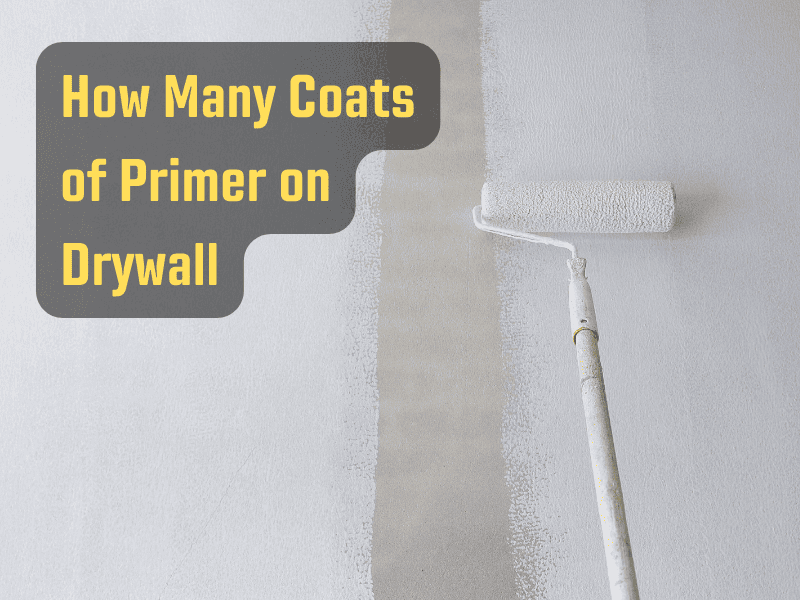When visualizing the transformation of a room through a fresh paint job, it’s easy to dream about the final flourish—the new color that will reinvigorate the space. However, the journey to that beautifully painted wall involves critical steps. One of them is applying primer, an element of the process that directly impacts your paint job’s final appearance, durability, and longevity. This guide will delve into this crucial stage of painting and address the central question: how many coats of primer are needed on drywall?
Table of Contents
Breaking Down the Primer Basics
To appreciate the reasoning behind the number of coats, let’s revisit the foundational role of primer in a painting project. Acting as the bridge between the drywall and the paint, primer serves several crucial functions:
- Sealing: Primer seals the porous drywall surface, preventing the paint from seeping in too much, which could lead to uneven color or patchy areas.
- Adhesion: It promotes the bond between the paint and the wall, ensuring a smooth, consistent application and reducing the likelihood of paint peeling or chipping over time.
- Color Enhancement: By providing a neutral base, the primer helps to reflect the chosen paint color accurately. In some situations, it also aids in obscuring the color of the surface beneath.
Understanding these critical functions underscores the importance of primer and sheds light on why the number of coats can be decisive in achieving a successful paint job.
Defining the Number of Primer Coats
As a general rule of thumb, a single coat of primer is sufficient for most drywall painting projects. If your drywall is new and has never been painted, one layer of quality primer is typically enough to prepare the surface for painting.
However, this rule doesn’t apply universally. Some scenarios demand a more nuanced approach where a single coat of primer may not be adequate. Let’s explore these circumstances:
- Damaged or Repaired Drywall: Drywall that has been patched or repaired may absorb primer differently compared to the rest of the wall. An additional coat can be advantageous to ensure uniform absorption across the entire surface.
- Significant Color Changes: If you’re transitioning from a dark color to a lighter one, two coats of primer can effectively conceal the previous color, thereby providing a neutral base for the new paint.
- High-humidity Environments: An extra coat of primer can counteract moisture-related issues such as peeling or blistering paint in rooms susceptible to high humidity levels, like bathrooms or kitchens.
Mastering Primer Application: Maximizing Each Coat’s Potential
Applying the correct number of primer coats is pivotal, but the way each coat is applied is of equal importance. Here are a few tips to enhance the effectiveness of your primer application:
- Invest in Quality: Choose a high-quality primer. While saving money with a cheaper option might be tempting, remember that your primer lays the groundwork for your final paint job.
- Even Application is Key: Aim to apply the primer evenly across the drywall surface. Use a roller for larger areas and a brush for corners and edges.
- Patience Pays Off: Allow enough drying time between coats or before applying the paint. Rushing this process can lead to disappointing results.
- Smooth It Out: Consider lightly sanding the wall after the primer has dried. This step can eliminate minor imperfections, creating a smoother surface for your paint.
Delving Deeper: Factors Influencing the Number of Coats
As each painting project is unique, there are several factors to consider when determining the number of primer coats needed:
- Type of Drywall: New, unpainted drywall is more porous and may absorb more primer than previously painted drywall.
- Drywall Condition: Areas of drywall that have been repaired or damaged can absorb primer differently, requiring additional coats to ensure a uniform finish.
- Color Transition: The contrast between the existing and new wall colors can influence the number of primer coats necessary.
- Primer Quality: Higher-quality primers generally offer better coverage and may require fewer coats than budget alternatives.
- Room Usage: Areas subjected to heavy wear or moisture, like kitchens and bathrooms, may benefit from additional primer coats to enhance durability and moisture resistance.
Conclusion: Embrace the Primer Stage
While one coat of primer is often sufficient for many drywall painting projects, there are certain situations where multiple coats may be beneficial. The art of painting is about understanding the specific needs of your project and making informed decisions based on those needs. With the proper application of primer, you’re preparing your walls and setting yourself up for a successful, satisfying, and stunning paint transformation. So embrace the primer stage—it’s your first step towards that dream room.
